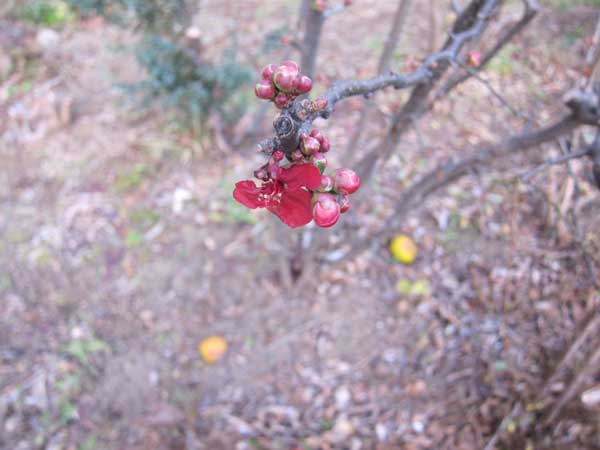
I love the deep blood red of this quince bud. Quince is called カリン (karin) in Japanese. In the background, you can see two chartreuse fruit fallen on the ground. Tokyo quince is not just decorative.

I love the deep blood red of this quince bud. Quince is called カリン (karin) in Japanese. In the background, you can see two chartreuse fruit fallen on the ground. Tokyo quince is not just decorative.
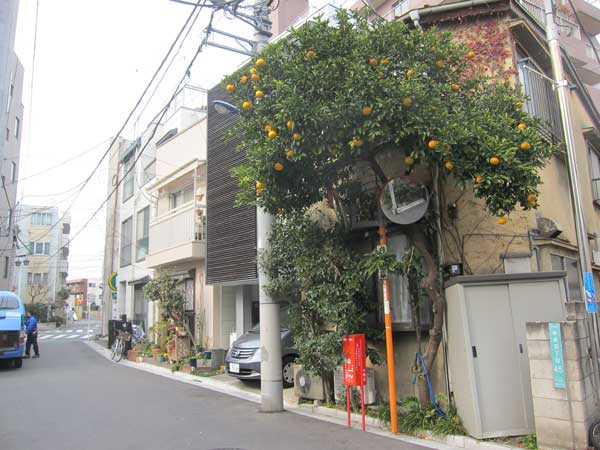
東京に来たとき、柑橘類の木を見て驚きました。冬に果物が熟成しますが、寒すぎるのではないかと思いました。最初、このハッサクは食べれないと東京の人はみんな言いました。去年カナダ人の友だちが、閉鎖された公立学校の庭でハッサクを収穫して、商店街の人たちと一緒にマーマレードを作りました。装飾にも食用にもなります。
Freezing temperatures and icy streets are keeping me indoors. But I am always amazed at how much still grows in Tokyo’s winter months. The most spectacular and surprising is this large citrus called “hassaku.”
For years I believed general comments about how the fruit is too sour to eat. Then I participated last year in Edoble’s hassaku marmalade-making. This tree can be seen everywhere in Tokyo, so it must be well suited. I like how it’s both decorative and edible!

東京の地元で出来た果物を食べたり、育てたり、分け合ったりしていますか。地元で取れた、非商業の果物に関する話を集めています。あなたの話を聞かせてください。
Do you eat, grow, or share local fruit in Tokyo? We are collecting stories about Tokyo local, or non-commercial, fruit. Please share yours.
Image: Jess Mantell. Project partners: Jess Mantell and Chris Berthelsen.

寒いときには、温室に来るのが熱帯林への安い休暇みたいです。夢の島熱帯植物館を訪れました。戦後、たくさんのごみで作られた島です。外でパパイアの並木を見ました。この果物を東京で育てることができますか。
The same week I participated in the Umi no Mori tree planting, I had the opportunity to re-visit Yume no Shima, Tokyo’s most famous artificial island made of waste. This urban development started in the 1950s. Now it’s a vast area with a sports club, botanic garden, playing fields, semi-wild palm landscape, a marina, and a still functioning incinerator. It’s showing its age with deferred maintenance and sparse usage.
I love how it’s named “Dream Island.” This time I visited the botanic garden. On the outside is a row of papaya trees, which I thought too tropical to grow outdoors in Tokyo. There’s also a row of ceramic frog planters leading to the front door. A green house is a great place to go on a cold day, like a brief tropical holiday at very low cost.
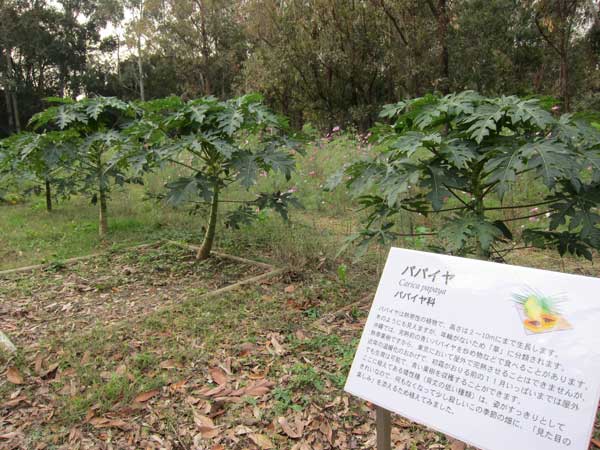



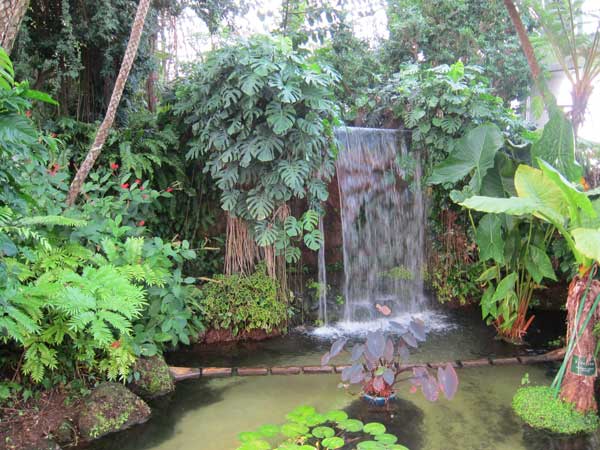
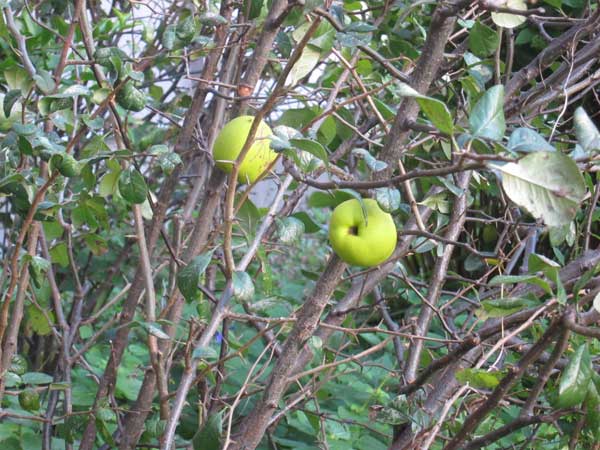
These fruit, too, also quickly appeared and then they were gone. The short tree is extremely thorny, and the fruit look like apples. I wonder if they are edible.
Thanks to Janet at Suiseki Art for the help with yesterday’s Chinese quince or “karin” in Japanese.
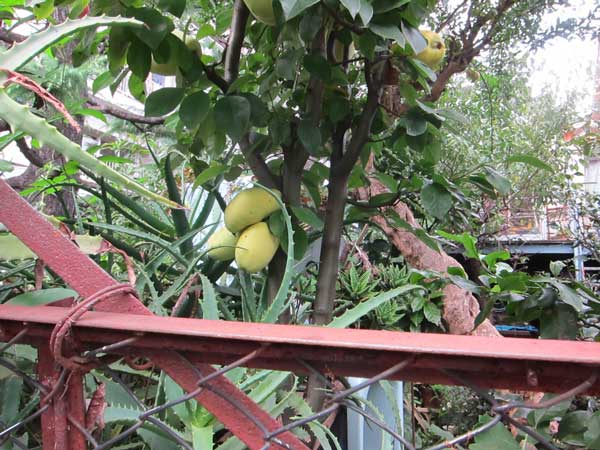

この柿の木は史火陶芸教室の裏庭で育っています。二年に一回、果物がたくさん出来ますが、多くない年もたくさんとれます。毎年、義理の母が生徒さんや友だちに果物と果物で作った料理をあげます。秋は柿です。夏はユスラ梅です。東京は、果物の木が多いことを知っている外国人が少ないです。
Many foreigners are surprised just how full of persimmons Tokyo is in the fall. Maybe you’d miss them if you stick to inside the newest malls and corporate developments. But it must be one of the most popular residential trees, and a true marker of fall.
This one is behind Shiho ceramic studio, and the funny story is that my in law teachers say that this year there aren’t so many fruit. Despite being an off year in a two year cycle, there’s actually still quite a lot of fruit. My mother in law is a great cook, and she uses these fall persimmons and also small sour plums in summer for food she shares with students and friends. She didn’t plant these trees but has gotten a lot of use from them in the past ten years.
Some persimmon trees produce fruit that’s best eaten raw, others dried, or cooked into jam or other sweets. For me it’s an acquired taste, but seeing these orange globes dangling across Tokyo is undeniably beautiful.


Through this blog, I was contacted by Edoble, whose tag line is “free food everywhere, in Tokyo.” Last month Edoble organized a hassaku marmelade party at a small shoutengai in Nakano, not far from where I live.
Edoble’s founder Jess Mantell is a Canadian designer, doctoral student, city explorer, and community organizer. As you can see from the poster above, she’s a great illustrator, too. At Keio University, she previously led a team that created an iPhone app that tracks movement across Tokyo with city sounds.
Edoble’s hassaku marmalade making event was great fun. Hassaku is a citrus tree that I often see growing in older gardens in Tokyo. The tree is very robust, and the fruits bright orange and large starting in winter. Seeing them makes me feel like there’s a bit of Florida or Southern California in Tokyo. But everyone had told me that the fruit is inedible. Jess’ idea was to bring people together to harvest and prepare hassaku.
It seems that if you pick the fruit at different times, the taste changes. Jess spotted mature hassaku trees in an abandoned city middle school near her house in south Nakano. She asked permission from the ward office to harvest the fruit in the spring, and several city workers unlocked the gate and joined her in collecting and sharing the fruit. That alone is pretty cool.
In June, Edoble hosted a marmalade party as a public event at a small space that is shared by the shoutengai association. On June 11, about twenty people very rapidly peeled the fruit, eliminated the membrane, put the seeds and membrane into a cheese cloth, and then boiled everything in four large pots. It was fun to see the amazing knife skills, particularly the older women and one young nursery school chef. We even got some help from some neighborhood kids.
The workshop was super-inspiring. It is great to realize how much food is growing in Tokyo, and that we can join with our neighbors in collecting and preparing super local food. Edoble’s accomplishment was in bringing together residents and local government, children and seniors, mostly Japanese and a few foreigners, mostly women and a few men.
Edoble reminds me that cities can grow a lot more of their own food, and that residents enjoy opportunities to work together and share food. Urban foraging is low cost and high return.



